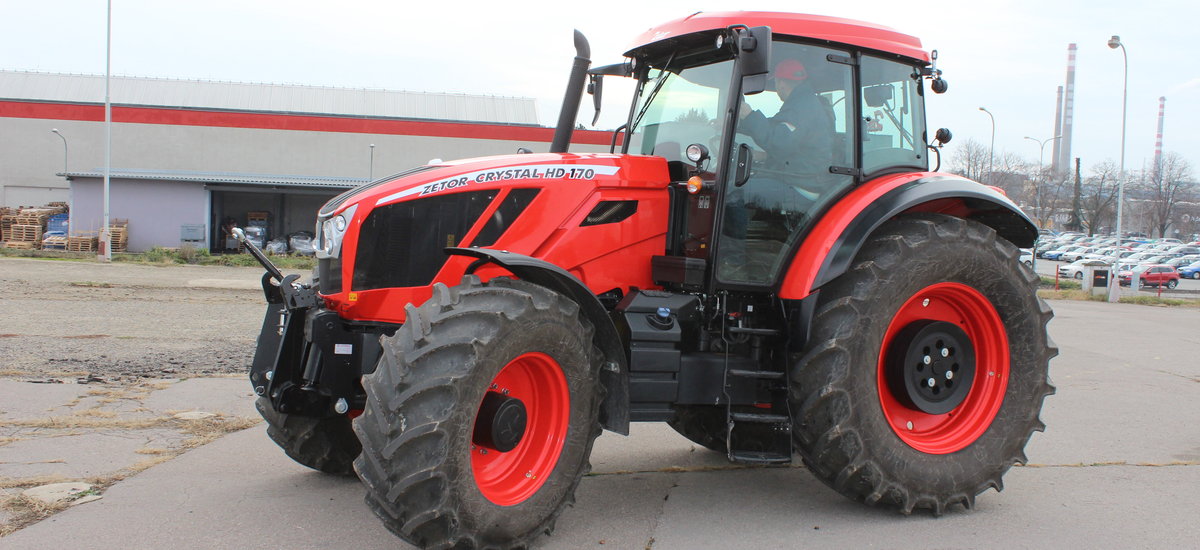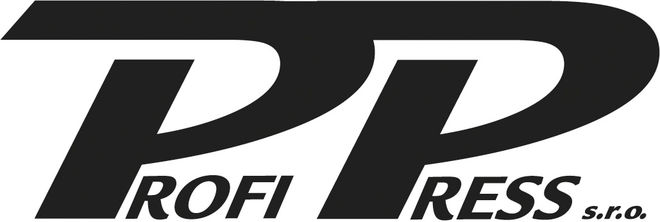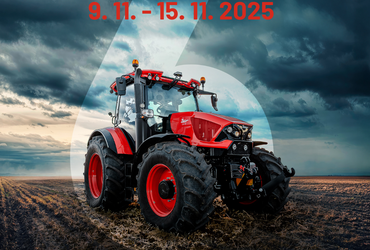- About Tractors
- 26.2.2019
Once more a step further – CRYSTAL review | Profi Press
Přihlášení

The innovative version of the Zetor Crystal tractor, carrying the addition of HD, has been in serial production since September and customers can now order Zetors with six-cylinder engines. I had the opportunity to try out the Crystal HD for a while, right on the manufacturer’s premises. Granted, there was no load, but even a brief ride brought a few interesting insights.
 The new range of Zetor Crystal HD tractors includes two designs, namely the HD 150 and HD 170. Those who are more interested in Zetors may recall that the original Crystals were the 150 and 160 models. One would therefore expect that the 170 model would have even higher performance. However, this is not the case, and the new models are exactly the same, providing 144 and 163 for nominal and 150 and 171 for maximum power. However, the torque has been slightly increased and the maximum (666/745 Nm) is between 1200 and 1600 rpm.
The new range of Zetor Crystal HD tractors includes two designs, namely the HD 150 and HD 170. Those who are more interested in Zetors may recall that the original Crystals were the 150 and 160 models. One would therefore expect that the 170 model would have even higher performance. However, this is not the case, and the new models are exactly the same, providing 144 and 163 for nominal and 150 and 171 for maximum power. However, the torque has been slightly increased and the maximum (666/745 Nm) is between 1200 and 1600 rpm.
Now with a particulate filter
The crucial difference between the new engines is that they meet Stage IV emissions, which required some modifications. Moreover, a particulate filter has been added to the SCR and EGR system. It's a classic design with active regeneration, which involves adjusting the injection, when the fuel is injected after the main injection which then burns in the exhaust pipe and increases the exhaust gas temperature required to burn the accumulated carbon soot.
The particulate filter has classic pressure and temperature sensors and the driver is informed of its condition on the instrument panel which displays the percentage of filter clogging, which is calculated from the pressure difference, as well as the amount of ash which is calculated from the number and length of regenerations.
The engine, a Deutz TCD 6.1 LG, utilises one turbocharger with pressure regulation, four-valve distribution and Common Rail fuel injection. A novelty (not related to the engine, but more about comfort in the driver's cab) is the possibility of setting a constant engine speed.
The new engine is also ready to meet the Stage V standard, and it must be said that with its onset, it will not be necessary to add new components to the exhaust pipe. The fuel tank has been reworked. Its volume is the same (300 l), but it has a different shaping which makes better use of free spaces in the tractor’s structure.
Fast at low revs
The gearbox of the new Crystal is, at first glance, unchanged, thus it is a five-speed synchronised gearbox with a reduction, a three-stage multiplier and a reverser under load. But there are changes to it. Finally, the name of the ECO 40 gearbox suggests a lot.
Namely, it has a new gearing. While the first three gears are the same as in the original gearbox (so that users do not feel the change during field work), the fourth and especially the fifth gear are more for higher speed. In the highest gear, the tractor can theoretically drive at 50 km/h. However, only theoretically, because the engine speed is electronically restricted to no more than 40 km/h.
The advantage of this different gearing is clear, namely fuel saving when driving at higher speed and with a lighter load. Typically, for example, when driving the tractor on its own, with tools, or during transport, especially when driving with an empty trailer or semi-trailer. Estimated fuel savings can be between 10% and 20%. The accompanying effect of lower engine speeds is also reduced noise. The new gearbox control has also been resolved. Instead of a long gear lever, which directly shifts the gear forks, there is a short gear lever with a separate gearbox control using cables. This modification has significantly improved changing gear. The automatic gear change multipliers are unchanged, one practical aspect is that the rev limiter for gear changing is now shown on the colour display.
Minor and significant changes
One minor but, in practice, interesting modification lies in the external control of the rear PTO shaft. Using the buttons on the rear mudguards, it can not only be rotated, but can also be run continuously or switched off. This is provided that the handbrake is engaged, and the gear is in neutral.
The rest remains, a wet clutch PTO with a modulated start-up and four independent speeds. Dependent speeds are no longer available on the HD version. The Carraro front axle has independent wheel suspension and lots of lubricators. The manufacturer has set up central lubrication where all the lubricant gathers in two places and thus speeds up maintenance. The use of brakes in the front axle wheels is also new. The Crystal HD brake system is interesting in general. While the rear axle has disc brakes with air control, the front brakes are hydraulically controlled (via the air/oil converter). The Crystal HD can be equipped with hydraulic single-line and pneumatic dual-line brakes for trailers and ABS is in preparation. An innovation related to a stricter directive known under the heading ”EU Mother Regulation” is the use of pressure sensors in the trailer and tractor braking system.
Now with electronic control
The toothed hydraulic generator, designed for the hydraulic system, has a flow rate of 85 l/min. The latter includes a three-point hitch with two auxiliary cylinders and a lifting force of up to 85 kN and an EHR with HitchTronic functionality. The four rear outer circuits come as standard, now with electronic time management and flow control, which is the same as for the Forterra HD. When using an additional distributor, the number of circuits can be extended to six, which comes in handy when the front TBZ or loader is mounted. Two circuits can be controlled using a joystick in the control panel. The external hydraulics also have a hydraulic coupling, now with a larger diameter.
Quieter cab
There are significant changes in the cab. Installing further silentblocks has improved its suspension but mainly reduced the level of internal noise and thus, logically, has also decreased the amount of dust and chemicals seeping in. The cab has also been raised by 10 cm. A practical innovation is the exterior step lighting which comes on at the same time as the interior lighting and goes off with a delay. Leaving the tractor parked in the dark is not a problem.
In relation to the previously mentioned control panel next to the seats, there is also a new instrument panel with a larger and more colourful information display showing multiple functions. So, for example, the performance parameters of the tractor’s consumption. The seats that have heating and springs not only in a vertical but also in a horizontal direction, adjustable lumbar support, a headrest and arm rests and a self-retractable belt. Storage areas have been added in the cab and cup holders for drinks.
Up to eight LED work lights plus two viewfinders and TBZ lighting can be mounted on the cab from the outside. This depends on the customer and whether they often work at night.
A few observations
Having driven the new Crystal HD, I would like to share my insights. The aforementioned noise reduction in the cabin is now significantly lower and the tractor control has improved, especially gear selection. Although, the first three gears are still a bit stiff (I tried a new tractor), but it’s quite easy to get into 4th and 5th.
Reversing worked well, only the initial start-up was less smooth, which was due to cold oil. I also tried out the automatic gear change torque multiplier. This was also functional, so we can see that the idea of simple settings was taken up. One impractical aspect is the fact that the automatic gearbox doesn't switch off if only automatic gear changing is selected whilst the driver manually operates the multiplier.
The hydraulic control can be described as standard, but the controls on the right rear pillar of the cab are nicely made, which are designed especially for PTO, suspension locking differentials, front axles and other features that are not used very often.
The constant speed control of the engine has been resolved conventionally. It has two memory and +/— switches to change the settings. The Auto button, which is related to constant revs, was a complete mystery to me and I did not understand its function.
The instrument panel is really successful, particularly aesthetically attractive is the information display. Personally, I like the information about the condition of the particulate filter, which is a component that can cause wrinkles for some users. However, if they monitor its condition and do not interrupt regeneration, most related problems can be avoided.
So what next?
Technically, the new Crystal HD has moved on a bit. And this innovation will continue. For example, it is now equipped with an ISO socket for connecting machinery which can take information from the CAN Bus network on the tractor. The conventional ISOBUS socket system will come with the advent of further modernisation. And there will definitely be more changes...
Text and photo Luboš Stehno


